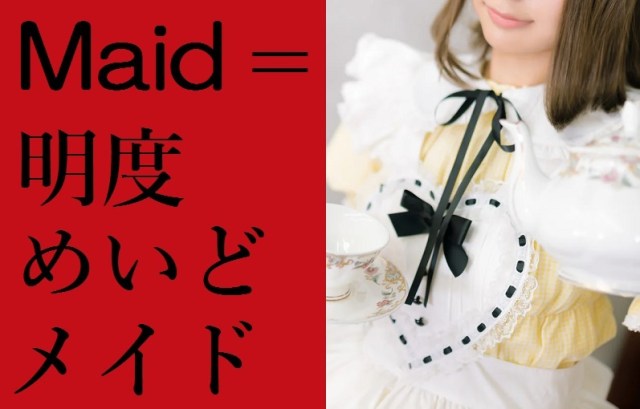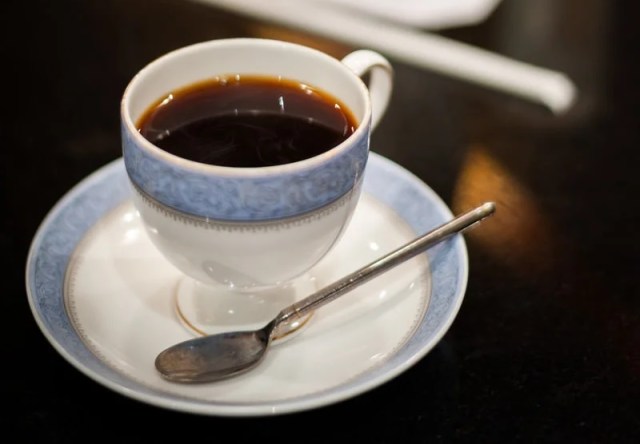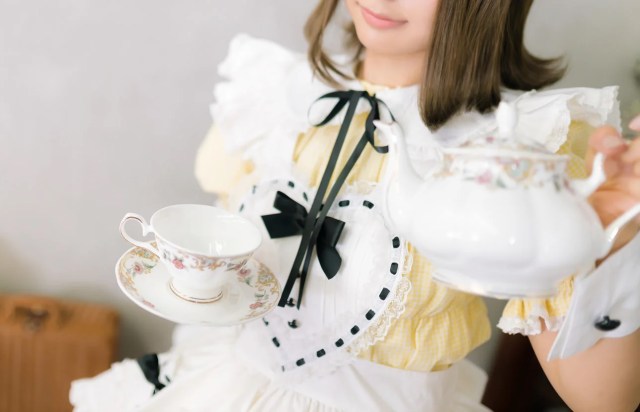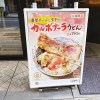
We’re back and ready to take on the third, and most puzzling, type of Japanese text: katakana.
Recently, we started taking a look at the question of why the Japanese language needs three sets of written characters. To recap, we saw that kanji (complex characters that originated in China) are used to symbolize a term or concept, while hiragana (simpler, indigenous Japanese characters) represent sounds and provide extra context and grammatical information.
What we haven’t talked about yet is why Japanese needs two sets of phonetic script. Aside from hiragana, there’s also katakana, yet another group of 46 low-stroke-count characters used for writing things phonetically. Specifically, katakana get used for writing foreign loanwords.
But wait. We don’t need a whole new set of letters to write foreign loanwords in English. What makes things different in Japanese? Let’s dive into the answer, and since it’s going to take a while to explain, go ahead and pour yourself a cup of coffee.
▼ Which, incidentally, is written with katakana as コーヒー.
As mentioned last time, there are two huge advantages to using a mix of kanji and hiragana. There’s an extremely limited number of sounds available in the Japanese language, which results in many Japanese words having the same pronunciation but wildly different meanings, but the conceptual meanings kanji possess help to avoid confusion. Second, since Japanese is written with no spaces between words, using kanji for vocabulary and kana for grammar (to put things in broad terms) makes it easy to see the components of a sentence.
▼ Watashi ha kuruma wo mita or “I saw the car,” with kanji (i.e. vocabulary) written in red and hiragana (i.e. grammar) in blue.
But that limited number of sounds means most foreign words can’t be properly rendered in written Japanese, which threatens to give the language even more homonyms. For example, let’s say we wanted to talk about a maid, of the maid cafe variety. Since Japanese syllables can’t end in a “D” sound, “maid” becomes meido (pronounced close to “maid-o”).
If we want to write meido in Japanese, it seems like the obvious thing to do is to write it in simple, phonetic hiragana. Technically we could do that, and it would look like this:
But this would make things confusing once we combined it with other words. Since hiragana is most commonly used for grammatical modifications, using it for a whole noun like “maid” can make it hard to see the breakdown of ideas in a sentence. Remember how easy it was to spot the breaks in “Watashi ha kuruma wo mita/I saw the car?” Look what happens when we replace the kanji for kuruma/car, 車, with meido, written all in hiragana (once again with kanji in red and hiragana in blue), to try to write Watashi ha meido wo mita/I saw the maid.
Now we’ve got that whole はめいどを cluster of hiragana, which makes it confusing to figure out where to draw the lines to separate the different ideas in the sentence. The は, めいど, and を are all serving different purposes, but because they’re in a singular mass of hiragana, it becomes difficult to differentiate one from the other. As a matter of fact, it can actually be somewhat confusing and cumbersome for Japanese adults to read young children’s storybooks if they’re predominantly written in hiragana without severely slowing down their reading speed so they can pick things apart.
OK, so now we’ve seen that using hiragana to write meido would be a bad plan. So how about writing it in kanji? The problem with that approach is that it raises the question of how, and more importantly when, to decide what the kanji for meido should be. There isn’t a starkly defined point at which vocabulary crosses over into other languages. Just look at the gradual manner in which “anime,” “otaku,” and “moe” have seeped into English.
In order to write everything in kanji, you’d need some sort of linguistic authority group constantly scanning for foreign words and developing new kanji for them before anyone in Japan has a need to write them. Even if such a framework existed, there’s the problem that if you chose the kanji based on how they’re pronounced, in an attempt to stay close to the original pronunciation of the loanword, the meaning of those individual kanji is going to be something completely different from that of the loanword they’re supposed to be representing.
▼ It’d be sort of like if I told you this picture represents a maid, and not approval, because “may” sounds similar to “maid.”
So now hiragana and kanji are both out. Using either for meido would both create new problems, and there’s no practical way to produce a universally accepted kanji for it either, so there needs to be another phonetic character set for writing foreign loanwords: katakana.
Which is why meido gets written in katakana like this:
Now armed with all three sets of characters, let’s go back and write Watashi ha medio wo mita again.
▼ Kanji in red, hiragana in blue, katakana in green
Now we’ve got a nice kanji-hiragana-katakana-hiragana-kanji-hiragana pattern, giving us the easy-to-spot breakdown of:
1. 私は: Watashi (I) and ha (the subject marker)
2. メイドを: meido (the maid) and wo (the object marker)
3. 見た: mi- (the verb see) and -ta (marking the verb as past tense)
Looking at the situation from the standpoint of how a language advances and evolves, katakana gives Japanese a way to quickly incorporate new concepts from other cultures with a non-kanji-based writing system. Without katakana, there’d be no way for Japan to efficiently add global ideas to its writing. Without hiragana, there’d be no way to easily modify grammar. And without either, you’d end up with basically the Chinese writing system, which makes the Japanese one look like a cakewalk in terms of difficulty for foreign learners.
Speaking of foreign learners, the existence of katakana actually works out in your favor, once you get the hang of some of the more common ways the pronunciation of foreign words gets corrupted in Japanese. Once again, say you’re reading the sentence Watashi ha meido wo mita/I saw the maid.
Even if you didn’t already know that meido is the Japanese word for “maid,” once you see that it’s written in katakana, you know it’s a foreign loanword. When you spot メイド, even if you’ve never seen the word used in Japanese before, you can ask yourself “Is there a word in English/French/Spanish/etc. that sounds like this?” and you’ve got a chance of deciphering the meaning on the spot.
Yes, until you get a little experience with the language and build up a base of vocabulary, sometimes it’s going to be extremely frustrating that Japanese has three different styles of writing. It didn’t all start making sense to me until a couple of months into studying the language, but one day it clicked, and in the roughly 20 years since I haven’t reversed my stance on it. Trust me, as weird as it might seem in the beginning, I’ve never met anyone for whom the relationship between kanji, hiragana, and katakana was the insurmountable stumbling block that kept them from becoming proficient in Japanese, so if that’s your goal, stick with it (and all three of them).
Got a burning question about Japanese? Ask Casey on Twitter! Got a question about any other kind of burning? Ask your doctor!
Top image: RocketNews24, Pakutaso (edited by RocketNews24)
Insert images: Pakutaso (1, 2), RocketNews24, Pakutaso (2)










 Japanese first grader wins math contest by quantifying “which hiragana are the hardest to write”
Japanese first grader wins math contest by quantifying “which hiragana are the hardest to write” Twitter users say Japanese Prime Minister’s name is hiding in the kanji for Japan’s new era name
Twitter users say Japanese Prime Minister’s name is hiding in the kanji for Japan’s new era name Video of each Japanese hiragana getting “measured up” is oddly cute and satisfying【Video】
Video of each Japanese hiragana getting “measured up” is oddly cute and satisfying【Video】 Foreigners in Japan vote for the best-looking katakana character
Foreigners in Japan vote for the best-looking katakana character Struggling with Japanese? Let Tako lend you a hand…or five
Struggling with Japanese? Let Tako lend you a hand…or five Red light district sushi restaurant in Tokyo shows us just how wrong we were about it
Red light district sushi restaurant in Tokyo shows us just how wrong we were about it Historical figures get manga makeovers from artists of Spy x Family, My Hero Academia and more
Historical figures get manga makeovers from artists of Spy x Family, My Hero Academia and more Sandwiches fit for a sumo served up in Osaka【Taste Test】
Sandwiches fit for a sumo served up in Osaka【Taste Test】 Tokyo Tsukiji fish market site to be redeveloped with 50,000-seat stadium, hotel, shopping center
Tokyo Tsukiji fish market site to be redeveloped with 50,000-seat stadium, hotel, shopping center McDonald’s new Happy Meals offer up cute and practical Sanrio lifestyle goods
McDonald’s new Happy Meals offer up cute and practical Sanrio lifestyle goods Akihabara pop-up shop sells goods made by Japanese prison inmates
Akihabara pop-up shop sells goods made by Japanese prison inmates Anime girl English teacher Ellen-sensei becomes VTuber/VVTUber and NFT
Anime girl English teacher Ellen-sensei becomes VTuber/VVTUber and NFT Pokémon Sleep camping suite and guestrooms coming to Tokyo Hyatt along with giant Snorlax burgers
Pokémon Sleep camping suite and guestrooms coming to Tokyo Hyatt along with giant Snorlax burgers Japanese ramen restaurants under pressure from new yen banknotes
Japanese ramen restaurants under pressure from new yen banknotes Limited-edition Carbonara Udon will anger noodle purists and pasta lovers 【Taste test】
Limited-edition Carbonara Udon will anger noodle purists and pasta lovers 【Taste test】 All-you-can-drink Starbucks and amazing views part of Tokyo’s new 170 meter-high sky lounge
All-you-can-drink Starbucks and amazing views part of Tokyo’s new 170 meter-high sky lounge More foreign tourists than ever before in history visited Japan last month
More foreign tourists than ever before in history visited Japan last month French Fries Bread in Tokyo’s Shibuya becomes a hit on social media
French Fries Bread in Tokyo’s Shibuya becomes a hit on social media Studio Ghibli releases new action figures featuring Nausicaä of the Valley of the Wind characters
Studio Ghibli releases new action figures featuring Nausicaä of the Valley of the Wind characters New private rooms on Tokaido Shinkansen change the way we travel from Tokyo to Kyoto
New private rooms on Tokaido Shinkansen change the way we travel from Tokyo to Kyoto Starbucks reopens at Shibuya Scramble Crossing with new look and design concept
Starbucks reopens at Shibuya Scramble Crossing with new look and design concept Studio Ghibli glasses cases let anime characters keep an eye on your spectacles
Studio Ghibli glasses cases let anime characters keep an eye on your spectacles Beautiful Ghibli sealing wax kits let you create accessories and elegant letter decorations【Pics】
Beautiful Ghibli sealing wax kits let you create accessories and elegant letter decorations【Pics】 Studio Ghibli releases Kiki’s Delivery Service chocolate cake pouches in Japan
Studio Ghibli releases Kiki’s Delivery Service chocolate cake pouches in Japan New definition of “Japanese whiskey” goes into effect to prevent fakes from fooling overseas buyers
New definition of “Japanese whiskey” goes into effect to prevent fakes from fooling overseas buyers Our Japanese reporter visits Costco in the U.S., finds super American and very Japanese things
Our Japanese reporter visits Costco in the U.S., finds super American and very Japanese things Studio Ghibli unveils Mother’s Day gift set that captures the love in My Neighbour Totoro
Studio Ghibli unveils Mother’s Day gift set that captures the love in My Neighbour Totoro New Japanese KitKat flavour stars Sanrio characters, including Hello Kitty
New Japanese KitKat flavour stars Sanrio characters, including Hello Kitty New Pokémon cakes let you eat your way through Pikachu and all the Eevee evolutions
New Pokémon cakes let you eat your way through Pikachu and all the Eevee evolutions Disney princesses get official manga makeovers for Manga Princess Cafe opening in Tokyo
Disney princesses get official manga makeovers for Manga Princess Cafe opening in Tokyo Sales of Japan’s most convenient train ticket/shopping payment cards suspended indefinitely
Sales of Japan’s most convenient train ticket/shopping payment cards suspended indefinitely Sold-out Studio Ghibli desktop humidifiers are back so Totoro can help you through the dry season
Sold-out Studio Ghibli desktop humidifiers are back so Totoro can help you through the dry season Japanese government to make first change to romanization spelling rules since the 1950s
Japanese government to make first change to romanization spelling rules since the 1950s Ghibli founders Toshio Suzuki and Hayao Miyazaki contribute to Japanese whisky Totoro label design
Ghibli founders Toshio Suzuki and Hayao Miyazaki contribute to Japanese whisky Totoro label design Doraemon found buried at sea as scene from 1993 anime becomes real life【Photos】
Doraemon found buried at sea as scene from 1993 anime becomes real life【Photos】 Tokyo’s most famous Starbucks is closed
Tokyo’s most famous Starbucks is closed One Piece characters’ nationalities revealed, but fans have mixed opinions
One Piece characters’ nationalities revealed, but fans have mixed opinions We asked a Uniqlo employee what four things we should buy and their suggestions didn’t disappoint
We asked a Uniqlo employee what four things we should buy and their suggestions didn’t disappoint Princesses, fruits, and blacksmiths: Study reveals the 30 most unusual family names in Japan
Princesses, fruits, and blacksmiths: Study reveals the 30 most unusual family names in Japan Pokémon Center apologizes for writing model Nicole Fujita’s name as Nicole Fujita
Pokémon Center apologizes for writing model Nicole Fujita’s name as Nicole Fujita Japanese mom at seaside hospital with no visiting hours gets a beautiful get-well message
Japanese mom at seaside hospital with no visiting hours gets a beautiful get-well message Japanese study tip: Imagine kanji characters as fighting game characters, like in this cool video
Japanese study tip: Imagine kanji characters as fighting game characters, like in this cool video Yahoo! Japan finds most alphabetic and katakana words Japanese people want to find out about
Yahoo! Japan finds most alphabetic and katakana words Japanese people want to find out about Japanese writing system gets turned into handsome anime men with Hiragana Boys video game
Japanese writing system gets turned into handsome anime men with Hiragana Boys video game Textbook gives Chinese otaku Japanese lessons with a side of anime girls and dialogue
Textbook gives Chinese otaku Japanese lessons with a side of anime girls and dialogue The awesome artwork hiding in the Japanese word processor: sakura, dragons, and sake
The awesome artwork hiding in the Japanese word processor: sakura, dragons, and sake Seven mistakes foreigners make when speaking Japanese—and how to fix them
Seven mistakes foreigners make when speaking Japanese—and how to fix them Foreigners misreading Japanese kanji of “two men one woman” is too pure for Japanese Internet
Foreigners misreading Japanese kanji of “two men one woman” is too pure for Japanese Internet “We wasted so much time in English class” — Japanese Twitter user points out major teaching flaw
“We wasted so much time in English class” — Japanese Twitter user points out major teaching flaw Learn Japanese through ridiculous manga: A Tick on Titan 【Episode #3】
Learn Japanese through ridiculous manga: A Tick on Titan 【Episode #3】 Anime-style magic circles summon vocabulary for you in this language-learning app from Japan【Vid】
Anime-style magic circles summon vocabulary for you in this language-learning app from Japan【Vid】 Foreign shop clerk and Japanese customer fail to communicate because of Japanese language quirk
Foreign shop clerk and Japanese customer fail to communicate because of Japanese language quirk The surprising reasons why some hiragana aren’t allowed to be used on Japanese license plates
The surprising reasons why some hiragana aren’t allowed to be used on Japanese license plates What’s funnier and more likely to make you study than poo? How about male pattern baldness?
What’s funnier and more likely to make you study than poo? How about male pattern baldness?
Leave a Reply